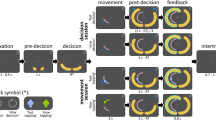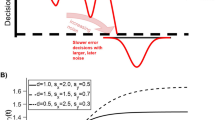Abstract
During intertemporal decisions, the preference for smaller, sooner reward over larger-delayed rewards (temporal discounting, TD) exhibits substantial inter-subject variability; however, it is currently unclear what are the mechanisms underlying this apparently idiosyncratic behavior. To answer this question, here we recorded and analyzed mouse movement kinematics during intertemporal choices in a large sample of participants (N = 86). Results revealed a specific pattern of decision dynamics associated with the selection of “immediate” versus “delayed” response alternatives, which well discriminated between a “discounter” versus a “farsighted” behavior—thus representing a reliable behavioral marker of TD preferences. By fitting the Drift Diffusion Model to the data, we showed that differences between discounter and farsighted subjects could be explained in terms of different model parameterizations, corresponding to the use of different choice mechanisms in the two groups. While farsighted subjects were biased toward the “delayed” option, discounter subjects were not correspondingly biased toward the “immediate” option. Rather, as shown by the dynamics of evidence accumulation over time, their behavior was characterized by high choice uncertainty.








Similar content being viewed by others
References
Abboud H, Schultz W, Zeitlin V (2006) SuperLab, stimulus presentation software (Version 4.0)
Ainslie G (1975) Specious reward: a behavioral theory of impulsiveness and impulse control. Psychol Bull 82:257–272
Barca L, Pezzulo G (2012) Unfolding visual lexical decision in time. PLoS One 7:e35932. doi:10.1371/journal.pone.0035932
Barca L, Pezzulo G (2015) Tracking second thoughts: continuous and discrete revision processes during visual lexical decision. PLoS One 10:e0116193. doi:10.1371/journal.pone.0116193
Berns GS, Laibson D, Loewenstein G (2007) Intertemporal choice: toward an integrative framework. Trends Cogn Sci 11:482–488. doi:10.1016/j.tics.2007.08.011
Calluso C, Tosoni A, Pezzulo G et al (2015) Interindividual variability in functional connectivity as long-term correlate of temporal discounting. PLoS One 10:e0119710. doi:10.1371/journal.pone.0119710
Chabris CF, Laibson DI, Schuldt JP (2008) Intertemporal choice. In: Durlauf SN, Blume LE (eds) The new palgrave dictionary of economics, 2nd edn. Palgrave Macmillan, Basingstoke
Daw ND, Niv Y, Dayan P (2005) Uncertainty-based competition between prefrontal and dorsolateral striatal systems for behavioral control. Nat Neurosci 8:1704–1711
Dshemuchadse M, Scherbaum S, Goschke T (2012) How decisions emerge: action dynamics in intertemporal decision making. J Exp Psychol Gen 142:93–100. doi:10.1037/a0028499
Figner B, Knoch D, Johnson EJ et al (2010) Lateral prefrontal cortex and self-control in intertemporal choice. Nat Neurosci 13:538–539. doi:10.1038/nn.2516
Fossati A, Di Ceglie A, Acquarini E, Barratt ES (2001) Psychometric properties of an Italian version of the Barratt Impulsiveness Scale-11 (BIS-11) in nonclinical subjects. J Clin Psychol 57:815–828
Freeman JB, Ambady N (2010) MouseTracker: software for studying real-time mental processing using a computer mouse-tracking method. Behav Res Methods 42:226–241. doi:10.3758/BRM.42.1.226
Freeman JB, Ambady N, Rule NO, Johnson KL (2008) Will a category cue attract you? Motor output reveals dynamic competition across person construal. J Exp Psychol Gen 137:673–690. doi:10.1037/a0013875
Freeman JB, Ambady N, Midgley KJ, Holcomb PJ (2011a) The real-time link between person perception and action: brain potential evidence for dynamic continuity. Soc Neurosci 6:139–155. doi:10.1080/17470919.2010.490674
Freeman JB, Dale R, Farmer TA (2011b) Hand in motion reveals mind in motion. Front Psychol 2:59. doi:10.3389/fpsyg.2011.00059
Gianotti LRR, Figner B, Ebstein RP, Knoch D (2012) Why some people discount more than others: baseline activation in the dorsal PFC mediates the link between COMT genotype and impatient choice. Front Neurosci 6:54. doi:10.3389/fnins.2012.00054
Green L, Myerson J (1996) Exponential versus hyperbolic discounting of delayed outcomes: risk and waiting time. Am Zool 505:496–505
Hamilton M (1960) Rating Scale for depression. J Neurol Neurosurg Psychiatry 23:56–62
Haxby JV, Parasuramen R, Lalonde F, Abboud H (1993) SuperLab: general-purpose Macintosh software for human experimental psychology and psychological testing. Behav Res Methods 25:400–405
Holland PW, Welsch RE (1977) Robust regression using iteratively reweighted least-squares. Commun Stat Theory Methods 6:813–827
Johnson MW, Bickel WK (2002) Within-subject comparison of real and hypothetical money rewards in delay discounting. J Exp Anal Behav 77:129–146. doi:10.1901/jeab.2002.77-129
Kable JW, Glimcher PW (2007) The neural correlates of subjective value during intertemporal choice. Nat Neurosci 10:1625–1633. doi:10.1038/nn2007
Kirby KN, Petry NM, Kirby K (2004) Heroin and cocaine abusers have higher discount rates for delayed rewards than alcoholics or non-drug-using controls. Addiction 99:461–471
Kobak KA, Reynolds WM, Maruish ME (1999) Hamilton depression inventory. The use of psychological testing for treatment planning and outcomes assessment, 2nd edn. Lawrence Erlbaum Associates Publisherssogs, Mahwah, pp 935–969
Lagorio CH, Madden GJ (2005) Delay discounting of real and hypothetical rewards III: steady-state assessments, forced-choice trials, and all real rewards. Behav Processes 69:173–187. doi:10.1016/j.beproc.2005.02.003
Laibson D (1997) Golden eggs and hyperbolic discounting*. Q J Econ 62:443–477
Lepora NF, Pezzulo G (2015) Embodied choice: how action influences perceptual decision making. PLoS Comput Biol 11:e1004110. doi:10.1371/journal.pcbi.1004110
Lesieur HR, Blume SB (1987) The South Oaks Gambling Screen (SOGS): a new instrument for the identification of pathological gamblers. Am J Psychiatry 144:1184–1188
Madden GJ, Begotka AM, Raiff BR, Kastern LL (2003) Delay discounting of real and hypothetical rewards. Exp Clin Psychopharmacol 11:139–145
Madden GJ, Raiff BR, Lagorio CH et al (2004) Delay discounting of potentially real and hypothetical rewards: II. between- and within-subject comparisons. Exp Clin Psychopharmacol 12:251–261
Mazur JE (1987) An adjusting procedure for studying delayed reinforcement. In: Commons M, Mazur J, Nevin J, Rachlin H (eds) The effect of delay and of intervening events of reinforcement value. Quantitative analysis of behavior, Vol 5. Erlbaum, Hillsdale, pp 57–73
McClure SM, Laibson DI, Loewenstein G, Cohen JD (2004) Separate neural systems value immediate and delayed monetary rewards. Science 306:503–507. doi:10.1126/science.1100907
Mitchell SH (1999) Measures of impulsivity in cigarette smokers and non-smokers. Psychopharmacology 146:455–464
Monterosso J, Ainslie G (1999) Beyond discounting possible experimental models of impulse control. Psychopharmacology 146:339–347
O’Leary DP (1990) Robust regression computation using iteratively reweighted least squares. SIAM J Matrix Anal Appl 11:466–480
Paninski L, Fellows MR, Hatsopoulos NG, Donoghue JP (2004) Spatiotemporal tuning of motor cortical neurons for hand position and velocity. J Neurophysiol 91:515–532. doi:10.1152/jn.00587.2002
Patton JH, Stanford MS, Barratt ES (1995) Factor structure of the Barratt impulsiveness scale. J Clin Psychol 51(6):768–774
Paulus MP, Yu AJ (2012) Emotion and decision-making: affect-driven belief systems in anxiety and depression. Trends Cogn Sci 16:476–483. doi:10.1016/j.tics.2012.07.009
Peters J, Büchel C (2011) The neural mechanisms of inter-temporal decision-making: understanding variability. Trends Cogn Sci 15:227–239. doi:10.1016/j.tics.2011.03.002
Pezzulo G, Rigoli F (2011) The value of foresight: how prospection affects decision-making. Front Neurosci 5:1–15. doi:10.3389/fnins.2011.00079
Pezzulo G, Rigoli F, Chersi F (2013) The mixed instrumental controller: using value of Information to combine habitual choice and mental simulation. Front Cogn 4:1–15
Philiastides MG, Auksztulewicz R, Heekeren HR, Blankenburg F (2011) Causal role of dorsolateral prefrontal cortex in human perceptual decision making. Curr Biol 21:980–983. doi:10.1016/j.cub.2011.04.034
Quinton J, Volpi NC, Barca L, Pezzulo G (2013) The cat is on the mat. Or is it a dog? Dynamic competition in perceptual decision making. IEEE Trans Syst Man Cybern Part A Syst 44:539–551
Ratcliff R, McKoon G (2008) The diffusion decision model: theory and data for two-choice decision tasks. Neural Comput 922:873–922
Ratcliff R, Rouder JN (1998) Modeling response times for two-choice decisions. Psychol Sci 9:347–356
Reynolds B, Ortengren A, Richards JB, de Wit H (2006) Dimensions of impulsive behavior: personality and behavioral measures. Pers Individ Dif 40:305–315. doi:10.1016/j.paid.2005.03.024
Sestieri C, Tosoni A, Mignogna V et al (2014) Memory accumulation mechanisms in human cortex are independent of motor intentions. J Neurosci 34:6993–7006. doi:10.1523/JNEUROSCI.3911-13.2014
Song J-H, Nakayama K (2009) Hidden cognitive states revealed in choice reaching tasks. Trends Cogn Sci 13:360–366. doi:10.1016/j.tics.2009.04.009
Spielberger CD, Gorsuch RL, Lushene RE (1970) The State trait anxiety inventory (STAI). Test manual for form X. Consulting Psychologist Press, Palo Alto. Trad. It. S.T.A.I. Questionario di autovalutazione dell’ansia di stato e di tratto a cura di Pedrabissi e Santinello (1989)
Spivey MJ (2007) On the continuity of mind. Oxford University Press, USA
Sullivan N, Hutcherson C, Harris A, Rangel A (2014) Dietary Self-control is related to the speed with which attributes of healthfulness and tastiness are processed. Psychol Sci 26:122–134. doi:10.1177/0956797614559543
Summerfield C, Tsetsos K (2012) Building bridges between perceptual and economic decision-making: neural and computational mechanisms. Front Neurosci 6:1–20. doi:10.3389/fnins.2012.00070
Van den Bos W, McClure SM (2013) Towards a general model of temporal discounting. J Exp Anal Behav 99:58–73. doi:10.1002/jeab.6
Vandekerckhove J, Tuerlinckx F (2007) Fitting the Ratcliff diffusion model. Psychon Bull Rev 14:1011–1026
Vandekerckhove J, Tuerlinckx F (2008) Diffusion model analysis with MATLAB: a DMAT primer. Behav Res Methods 40:61–72
Acknowledgments
We wish to thank Giulia Piraino for her help during data collection.
Funding
Research funded by the EU’s FP7 under Grant Agreement No FP7-ICT-270108 and the HFSP under Grant Agreement RGY0088/2014 to GP, and University G. d’Annunzio research funds to GC.
Author contribution
C. C., A. T., G. P and G. C. designed research; C. C. performed research; C. C., A. T., and N. L. analyzed data; and C. C., A. T., G. P., N. L. and G. C. wrote the paper.
Author information
Authors and Affiliations
Corresponding author
Appendix
Appendix
This Appendix summarizes the methods used in the Embodied Choice model to calculate the action focus; for further details, see Lepora and Pezzulo (2015). Mathematically, we represent the action focus as a point (x (z), y (z)) that is a function of the accumulated information z(t). At each instance of time, the action is a move (Δx, Δy) from the present location toward the action focus
which for simplicity we assume is at constant speed v taken at discrete time steps of Δt.
In the two-target forced choice task considered here, we consider a preparatory move toward an action focus between the two targets, to approach the most likely target prior to accumulating sufficient information to make a decision. Mathematically, we define the focus as collinear with the two targets with distance from each in the proportion ∣b + z∣: ∣b − z∣ for −b ≤ z ≤ b
This range is bounded such that the focus is coincident with a target if the decision bound is passed. Hence, the decision bound no longer defines decision termination directly, but rather the choice follows indirectly from action completion (upon reaching a target).
Rights and permissions
About this article
Cite this article
Calluso, C., Committeri, G., Pezzulo, G. et al. Analysis of hand kinematics reveals inter-individual differences in intertemporal decision dynamics. Exp Brain Res 233, 3597–3611 (2015). https://doi.org/10.1007/s00221-015-4427-1
Received:
Accepted:
Published:
Issue Date:
DOI: https://doi.org/10.1007/s00221-015-4427-1




